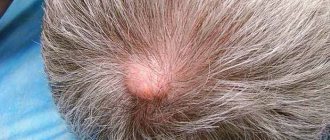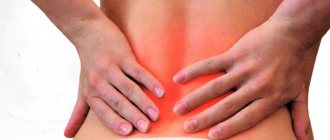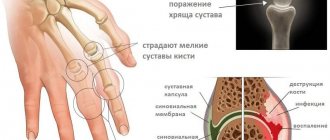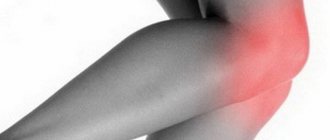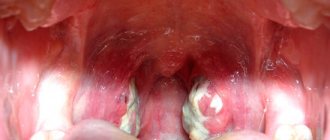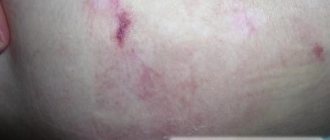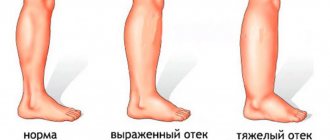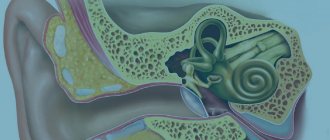A dental cyst is a neoplasm that resembles a capsule in shape and is localized in the jaw bone tissue, mainly in the area of the apex of the root canal of the affected tooth. A dental cyst, the symptoms of which in most cases appear only in the late stages of this pathology, as certain classifications indicate, is inextricably linked with granuloma, which, in turn, acts as a preceding process.
- Description of the disease
- Causes
- Symptoms
- Complications
- Diagnostics
- Treatment
How does a tooth root cyst appear?
The causes of cysts are varied, and among them it is impossible to single out the prevailing ones. So, this may be the result of physical trauma to the maxillofacial bones, or a rare but common medical error, in which the tightness of the root canal was broken, which became the basis for the emergence of a source of infection. A similar situation occurs when a dental crown is installed incorrectly. But the reasons for cyst formation are not limited to this. Untreated infectious diseases (in particular, sinusitis or periodontitis) are no less a provoking factor.
Causes of odontogenic cysts
The main reason is the penetration of infection into periodontal tissue. Infection can occur in various ways:
- Tooth injury due to a blow or fall;
- Infection in the root canal due to unscrupulous dental treatment;
- Infection of periodontal tissues with endodontic instruments;
- The entry of pathogenic bacteria into the periodontium along with the bloodstream after an infectious disease;
- The appearance of a cyst as a consequence of a chronic inflammatory process under the crown;
- Transition of chronic periodontitis into an odontogenic cyst;
- Complication of sinusitis with a chronic course;
- Formation of a dental cyst during complicated eruption of wisdom teeth.
But, despite such a long list of reasons, all of the above boils down to the fact that an infection gets into the periodontal tissues and provokes cystic tooth disease. Therefore, you need to try to take care of your teeth and seek help only from a trusted and experienced dentist.
Classification of dental cysts
There are not many types of cysts, so understanding them is not difficult. Four main types are distinguished by location:
- wisdom tooth cyst;
— a cyst due to an illiterate (unprofessional) installed dental crown;
- a cyst that arose as a result of the influence of a third-party infectious disease (sinusitis);
- a cyst localized in the area of the front teeth.
At the same time, a classification is used based on previous circumstances preceding the occurrence of the cyst:
- a disease caused by poor-quality removal of one or more teeth;
— periodontal type cyst, provoked by an inflammatory process in the gums;
- a cyst caused by the growth of a wisdom tooth (retromolar or paradental);
- a cyst that occurs in children, first during the period of the appearance of milk (follicular) teeth, and then molars (eruption cyst);
— a cyst that arose as a complication of periodontitis (radicular);
— a situation is also possible in which the tissue forming the tooth degenerates (keratocyst).
Complications
If a cyst is not detected in a timely manner, it gradually grows, resulting in the destruction of bone tissue while simultaneously replacing it with formations based on connective tissue. Complications of a dental cyst in this case can cause the loss of this tooth. As for other complications, most often they include the following pathologies:
- melting of the jaw bone tissue due to the gradual growth of the cyst;
- inflammation of the lymph nodes;
- purulent form of cyst inflammation;
- development of periostitis or osteomyelitis due to exposure to chronic inflammation;
- development of a chronic form of sinusitis due to the germination of a cyst into the maxillary sinuses;
- the formation of an abscess on the cheek or gum due to purulent inflammation, which is relevant both for the cyst and for the granuloma that precedes it;
- the appearance of phlegmon of the neck due to a long course of purulent inflammation;
- development of sepsis with concomitant blood poisoning;
- a fracture of the jaw of a spontaneous nature, occurring due to significant growth of the cyst with actual thinning of the bone in the area of the base of the jaw.
As you can see, complications in some cases of their manifestation are very serious, therefore, in the case when a tooth cyst hurts, you should definitely seek medical help, because such pain may indicate the onset of purulent inflammation. The smell of pus in the nose should also alert you - this may indicate the onset of an inflammatory purulent process in the maxillary sinuses.
Diagnosis of symptoms of tooth root cyst
The appearance of a cyst implies the formation of a cavity, which gradually grows while simultaneously filling with pus. This condition can last for a long time, and the patient does not experience pain. A sign suggesting the presence of a cyst is slight pain that occurs when pressing on the gum. Such a symptom only in rare cases becomes a reason to visit a dentist. Basically, it occurs in later stages, when the pain intensifies and becomes nagging, continuous, cannot be relieved with analgesics, and inflammation begins to additionally manifest itself in the form of swelling and swelling of the gums in combination with a persistent unpleasant odor in the oral cavity. Finally, a situation cannot be ruled out in which a fistula occurs - that is, a channel through which the contents of the cavity independently come out.
An effective way to detect a cyst in a timely manner is to conduct an X-ray examination followed by its opening and removal.
It should be noted that at the very beginning the disease poses minimal danger to surrounding tissues, since the cavity itself is reliably isolated by thick walls. However, as pus accumulates, the pressure on the walls increases, creating the possibility of a breakthrough, which can lead to blood poisoning and, in the long term, damage to the structure of the jaw bones. At the same time, the dynamics of cyst development are unpredictable and strictly individual. However, in the presence of other inflammatory processes or infections, in a weakened body the transition to the acute stage can occur quickly.
Particular attention should be paid to early diagnosis of the disease in pregnant women. This is due to the complexity of treatment: during pregnancy, only stabilization of the cyst is possible. If the inflammatory process worsens, the choice of treatment methods is strictly limited. That is why, at the planning stage of pregnancy, it is necessary to undergo a full examination by a dentist.
Clinical manifestations
At the initial stage of its development, the pathology does not have any characteristic signs. In some cases, the patient may feel slight discomfort due to mechanical impact on the affected area of the gum. Over time, the formation increases in size, and an excess amount of purulent exudate accumulates in its cavity. At this stage, specific signs appear.
The disease in an advanced stage has the following symptoms:
- Constant aching pain in the affected area. It is moderate in nature, but with a strong impact on the gums, the pain syndrome manifests itself more intensely.
- The pain has unclear localization, the patient experiences discomfort in the jaw area and deep in the nose. At the same time, it is almost impossible to eliminate them with the help of painkillers.
- Swelling and hyperemia of the gums, development of bleeding.
- Deformation of the facial contour (swelling of the cheek due to the development of inflammation).
- Bad breath.
- Formation of a fistulous tract on the gum surface. This sign indicates that the membrane of the neoplasm has broken through and pus flows out through the resulting hole.
- Deterioration in health, headaches, decreased motor activity and ability to work, increased body temperature to subfebrile levels (about 37.5 degrees).
Tooth root cyst in children
The disease has features and varieties that are characteristic strictly for children. First of all, we are talking about formations that arise and go away on their own, without complications: in the form of a rash that appears on the gums, as well as the so-called “Epstein’s pearl”. Both varieties do not pose a danger due to the absence of purulent masses, which means that the cavity is infected. In addition, they may not occur at all, being only some of the phenomena accompanying the development of the child.
The situation is different with the appearance of a cyst during the growth of teeth (both milk and molars). In this case, the resulting cavities are infected, and given the previously described asymptomatic nature of the disease in the early stages, the most reliable method of determining its presence is regular visits to the doctor. This allows for successful treatment at the very beginning of the development of the cyst, saving the tooth in almost 100 percent of cases.
Dentist advice
After using therapeutic or surgical techniques to remove a cyst, the patient must adhere to certain rules. This will reduce the risk of complications and speed up the healing process.
Dentists recommend:
- Protect the affected area from any influence as much as possible.
- Stop smoking and drinking alcohol.
- Regularly rinse your mouth with antiseptic solutions, but do this as carefully as possible, without making sudden movements.
- In the first 2-3 days, it is recommended to refrain from hygiene procedures (brushing your teeth).
- Do not use warm compresses.
- Take painkillers only when absolutely necessary and as prescribed by your doctor.
- Do not eat too hard foods, hot, cold, or spicy foods.
Methods for treating dental cysts
As mentioned earlier, the only reliable and error-free method for diagnosing a cyst on the root of a tooth is an x-ray. In most cases, one x-ray is sufficient; however, due to individual tooth growth patterns, an additional x-ray of the root portion may be required.
Based on the analysis of X-ray data, the dentist determines and prescribes the type of treatment. Due to the difficulty of accessing the cavity, the process of getting rid of the cyst can take several sessions - however, only this method allows you to eliminate the pathology while keeping the tooth itself healthy.
There are two main directions of treatment: therapeutic and surgical.
— the sequence of actions during therapeutic treatment is as follows: the dentist gains access to the intradental canals (to do this, the tooth tissue is opened), expands them, cleans the cavity from pus, then disinfects it and installs a temporary filling. In the absence of relapse and a favorable outcome, the temporary filling is replaced with a permanent one. An alternative option may be the depophoresis method. Its difference is that the cleaning of the canals occurs due to the sequential introduction of a special substance into them, which, under the influence of an electric current, disinfects them. The common property of both methods is their applicability in the early stages of the disease;
— surgical intervention is used in most cases due to its reliability and high efficiency. There are three types of surgical treatment: cystectomy, hemisection and cystotomy. The first option involves opening the gum from the side and removing the cyst, followed by suturing. Rehabilitation takes place while taking antibiotics. Hemisection requires additional removal of the affected tooth root and crown fragment. If a cystotomy is prescribed, penetration into the cavity is carried out through the near wall. This method has a significant rehabilitation period.
In addition to the above methods, laser therapy is used. Its principle of operation is to insert a thin tube into the cyst, allowing complete disinfection using a laser, followed by vacuum cleaning. This progressive method is painless and effective, since it is guaranteed to preserve the tooth and protect against recurrence of pathology.
Treatment regimen
The therapy is complex; the choice of one method or another depends on the size of the lump, the course of the disease, the causes of development and the characteristics of the patient’s health. Therapy often includes taking antibacterial drugs, using conservative methods and home recipes, and using minimally invasive laser technologies.
In severe cases, the patient is prescribed surgery.
Antibiotics
It is impossible to remove a tumor using antibacterial agents alone, but taking antibiotics is a must in proper therapy, because these drugs suppress the activity of bacteria, the main cause of the development of pathology. In addition, antimicrobial drugs prevent the risk of secondary infection of damaged tissues. Also, taking antibacterial agents is necessary during surgical operations and in the postoperative period.
The following drugs are most often prescribed: Pefloxacin, Amoxicillin, Ciprofloxacin, Sumamed. These medications must be used with caution, strictly following all doctor’s recommendations regarding dosage, rules and duration of use. Otherwise, side effects may develop.
Conservative methods
Conservative therapy is a long-term event that includes several stages:
- Opening the tooth canal to gain access to the tumor capsule.
- Rinsing with antiseptic solutions, antibacterial treatment of the lesion.
- Cleansing the cavity from purulent contents, sanitation of damaged tissues.
- The use of regenerating drugs that accelerate the wound healing process.
- Temporary cavity filling using special dental pastes.
- X-ray to determine the dynamics of tumor reduction. This procedure allows us to judge the effectiveness of the prescribed treatment.
- Installation of a permanent filling made of polymer materials.
- Preventive examinations for 5 months to prevent the development of relapses of the pathology.
Laser Application
The use of laser technology is the modern and safest method of cyst removal, making the procedure as comfortable as possible for the patient. A thin tube is inserted into the damaged area, after which a laser is applied to the affected gums. This allows you to relieve inflammation and disinfect the infected area. In addition, radiation negatively affects neoplasm cells, leading to their destruction. Tumor decay products are removed using a miniature vacuum pump. The use of laser technology allows you to effectively cope with the problem and maintain the health of your teeth and gums.
Surgery
In some cases, surgery is the only possible effective method of removing tumors. Surgery is necessary if there are large cysts, as well as if there is a risk of developing dangerous complications.
The following types of surgical intervention are distinguished:
- Hemisection , which involves partial removal of the dental crown, the affected tooth root and, directly, the neoplasm itself.
- Cystectomy. During the operation, the doctor cuts the front edge of the gum, through this incision the capsule and part of the apex of the tooth root are removed. After the procedure, the wound is treated with an antiseptic solution, and the patient is prescribed antibiotics.
- Cystotomy involves opening the capsule and cleaning its cavity. In some cases, the affected tooth may need to be removed. The operation allows you to reduce the size of the tumor and restore the bone tissue of the jaw. The patient requires a long recovery period, during which it is necessary to take antibacterial drugs.
Therapy at home
It is impossible to get rid of the problem at home; traditional medicine can only eliminate unpleasant symptoms and alleviate the patient’s condition. Herbal decoctions based on chamomile and sage are often used (1 tablespoon of raw material is brewed with a glass of boiling water). You need to rinse your mouth with these decoctions several times a day.
A solution of sea salt (1 teaspoon per glass of warm water) is also suitable for rinsing.
To relieve inflammation and reduce pain, you can apply a cotton swab soaked in clove or tea tree oil to the sore spot.
Rehabilitation period and prevention of dental cysts
Due to the fact that the cyst is an inflammatory infectious process, drug therapy necessarily includes taking antibiotics, which are selected by the attending physician. Vitamin complexes and immunomodulators act as compensating medications. Treatment of dental cysts with medications is carried out simultaneously with removal of the cyst.
The main ways to avoid the disease are to regularly visit the dentist and carefully monitor oral hygiene. For preventive purposes, you can periodically rinse with infusions and decoctions - for example, aloe, calendula, sage. Combined with strict adherence to the dentist’s recommendations and timely relief from chronic nasopharyngeal diseases, this will ensure dental health for years to come.
You also need to clearly understand that a cyst on the root of a tooth is one of the serious and complex diseases, the treatment of which requires time and highly qualified surgeons. Only this guarantees the absence of complications: re-infection, the occurrence of an abscess, pulpitis or fistula, damage to adjacent tissues and teeth.
Diagnostics
In order to identify the presence of a disease, the doctor assesses the totality of the patient’s complaints, after which he conducts a visual examination of the oral cavity. This allows you to determine the possible cause of cyst formation. To obtain more detailed information, the patient is prescribed an X-ray examination.
In the image obtained during the procedure, you can clearly see the neoplasm, which allows you to determine its shape, size and location. In some cases, additional diagnostic procedures are prescribed: radiovisiography (computer X-ray), CT (computed tomography).
What can you do yourself?
Considering only home methods for treating dental cysts without professional help from a dentist in a clinic, you should immediately make a reservation that completely getting rid of this problem is impossible in this way.
Homeopathic and other folk remedies are used in combination with specialized dental techniques as a necessary addition.
Folk remedies can improve the patient’s general condition, significantly alleviate symptoms and speed up recovery. However, home remedies are not used as the main treatment method.
This is especially true for those difficult cases when doctors recommend surgical treatment with removal of the tumor. Or a therapeutic method with the introduction of certain drugs into the root canals for the purpose of cleaning and disinfection, as well as subsequent filling.
It is simply impossible to do this at home. However, if the cyst provokes the formation of a fistula, home auxiliary therapeutic measures cannot be avoided. Most of them help:
- eliminate painful sensations;
- localize and even completely eliminate the resulting inflammation in the tissues ;
- suppress infection;
- effectively disinfect the oral cavity to prevent further development of inflammation.
What are the symptoms of a dental cyst?
Photos and signs of the disease. How to get rid of caries at home in 1 day? Here are some tips.
Herbal infusions
Many plants have medicinal properties that will help fight a cyst formed on the root of a tooth. Among these properties are disinfection of the oral cavity and elimination of infection, pain relief, and relief of inflammation.
Sometimes, with properly selected folk remedies, the cyst even resolves. The main method of using these beneficial properties is to prepare herbal infusions for rinsing.
The most effective in combating this dental problem are:
- sage;
- creeping thyme;
- yarrow;
- chamomile;
- horsetail;
- calendula;
- eucalyptus;
- medicinal hyssop.
The decoction can be prepared quite quickly and easily. The rules apply to all plants used:
To prepare the medicine, pour two full tablespoons of any selected and pre-chopped herb or a mixture of dried plants with boiling water (about a glass).
Then the container is tightly closed, additionally wrapped in a towel or cloth and left to infuse. The decoction is considered ready after complete cooling.
Decoctions can be used in different ways. The most common of them are mouth rinses , as, indeed, for all other home remedies. A variation of this method is baths , when the liquid is simply in the mouth without moving.
You can also use the lotion - moisten cotton wool generously and apply it to the painful area where the cyst and the area of soft tissue inflammation are located.
After just a few days of daily rinsing 4-6 times , the pain is practically not felt, and the inflammation of the soft tissues is significantly reduced.
Decoctions can also be used for indirect, and in this case, general treatment . Since the cause of the cyst is an infection, and after the formation of the cyst it is its source, the body tries to fight it using its own defenses.
This is not always enough. By regularly taking courses of various herbal decoctions, both pure and mixed, you can strengthen your immune system and help your body get rid of the disease on its own.
What does dental caries look like and manifest itself? Photos of stages, treatment, prevention.
This article contains expert recommendations on what to do if a wisdom tooth grows into the cheek.
Every patient should know why a tooth hurts after filling, if the nerve was not removed.
Alcohol infusions
Alcohol is one of the most common antiseptics in medicine (both professional and folk). It is used not only on its own, but also as various tinctures.
The easiest way to use alcohol to improve the condition of a dental cyst is to briefly rinse your mouth with regular vodka or diluted medical alcohol .
This will help reduce pain and help kill infection and bacteria. It is advisable to carry out the procedure several times a day .
Alcohol tinctures of medicinal herbs act somewhat differently. The excellent antiseptic properties of the alcohol itself are enhanced by the healing, bactericidal, anti-inflammatory effects of additional ingredients.
At the same time, the properties of plants also appear more clearly, since alcohol acts as a catalyst. The most effective for tooth cysts are alcohol tinctures of ficus and horseradish root.
The preparation method will be the same in both cases, as well as for other plants. It is necessary to finely chop the plants (here it is advisable to use freshly picked rather than dried herbs), pour it with medical alcohol in a one-to-one ratio or, in its absence, with regular vodka.
This mixture should be infused for three to five days, depending on the alcohol concentration, in a place that is well protected from children, dark, cool and well ventilated. After this, the resulting product can be filtered so that plant particles do not enter the oral cavity.
Read also: White ulcer on the gum
A cotton pad is soaked in the tincture and applied to the damaged area for several hours. After this, you should rinse your mouth thoroughly, preferably with antiseptic decoctions.
Additionally, you can rinse with alcohol infusion. However, in this case, it is necessary to reduce its concentration using clean, barely warm water, that is, simply dilute it with water.
Salt infusions
One of the oldest, proven, effective and, moreover, completely safe ways to combat the consequences and symptoms of a dental cyst is the old-fashioned method of using saline solutions.
Saline solution effectively relieves inflammation of soft tissues, destroying most of the bacteria and preventing their further development.
Saline solution is used mainly for rinsing. At the same time, all the basic rules for the preparation and subsequent use of solutions remain unchanged. Use only clean, possibly boiled water at room temperature.
For a glass of water - just one teaspoon of regular table salt. For better dissolution, you can pour a small amount of boiling water over the salt, and then simply add cool water or wait until the solution has cooled.
You should rinse thoroughly, holding the liquid in your mouth for a while without swallowing, and the number of procedures can be set independently. It all depends on how much the disease and its manifestations bother you.
It is recommended to carry out the procedure every hour and a half. This break between salt rinses is optimal. However, with the modern pace of life, this is not always possible. Therefore, the frequency of rinsing can be reduced without much damage.
sea salt to prepare the solution . In many cases, this significantly increases the effectiveness of the technique, accelerating recovery, since sea salt contains many minerals and trace elements that have a beneficial effect on the condition of the oral cavity.
Such oils resemble tinctures in their action, but the beauty is that you don’t have to make them yourself, wasting precious time on it. In addition, oils cannot simply be purchased at the nearest pharmacy.
There you can probably find small bottles with compound oils that combine the effects of several plants at once.
It is best to use tea tree, mint, and bergamot oils . Also very effective are the essential oils of those plants that are usually used to prepare decoctions.
In this form, their properties are more pronounced, and, accordingly, the effectiveness of treatment increases. Essential oils are an extremely concentrated product. Because of this, they should be used with extreme caution.
You can prepare water mixed with a few drops of oil, or you can dilute the required essential oil with sesame oil. The latter is also antiseptic and will help in treatment.
Cotton wool soaked in a mixture of oils is applied to the fistula and left for several hours.
Sesame oil is also often used for home treatment of dental cysts. For proper treatment, it is necessary to carry out a certain procedure several times a day (about four to five, sometimes less).
Take one teaspoon of oil and hold it in your mouth for at least seven minutes, without swallowing or rinsing. With this, you can not only control the spread of infection, but also effectively fight it.
In parallel with treatment with sesame oil, you can make compresses from clove oil , which helps relieve swelling of the soft tissues of the gums and significantly reduce inflammation, stopping the further development of the disease.
This video details the healing properties of tea tree oil:
Medications
Additionally, you can use some medications at home. These drugs, which combat the effects of the cyst and its symptoms, can be found in most pharmacy chains and can be purchased for a reasonable price without a prescription (except for antibiotics).
Their use is also quite effective. However, it should be remembered that self-administration of medications without consultation and prescription of a doctor can lead to undesirable consequences.
Therefore, such products should be used with caution, fully following the instructions regarding dosages, methods and duration of use, as well as taking into account contraindications and interactions with other substances and drugs.
The most common medications in the independent fight against dental cysts are:
- hydrogen peroxide;
- permanganate (potassium permanganate, which is sold in the form of a powder of small dark pink, almost black crystals);
- antiseptic solutions , for example, chlorophyllipt for rinsing;
- antibiotics against inflammation, for example, lincomycin;
- nimesil (nimesulide) for inflammation and pain relief;
- various painkillers - ketanov, ketarol, etc.
If you find an error, please select a piece of text and press Ctrl+Enter.
How to reduce the risk of disease
Of course, you cannot protect yourself one hundred percent from the occurrence of this disease, but you can take a number of measures to reduce the risk of a cyst appearing on a tooth:
- Visit your dentist regularly, take regular X-rays of your teeth;
- monitor your dental health and complete treatment;
- avoid injury to teeth and jaw;
- follow the rules of dental hygiene;
- Monitor your general health and your immunity.
These simple rules will help you reduce the likelihood of this disease occurring. If you have been diagnosed with it, then remember that its timely treatment or removal will save you from possible negative consequences.
Question answer
Is it painful to remove a tooth with a cyst?
All surgical procedures are performed under local anesthesia. In difficult cases, when treating children, general anesthesia is possible. Then hospitalization in the maxillofacial department of the hospital is indicated.
Can a dental cyst resolve on its own?
Dentists, based on personal experience and medical statistics, are unanimous in their opinion - it will not resolve. Even if the growth of the tumor has stopped, this stable state will last until the first cold or any other disease accompanied by a weakening of the body’s immune defense or pregnancy.
What to do if a cyst is found? The answer is simple - get quality treatment. Currently, methods are used that can help save a tooth, and the procedure itself does not take much time.
Teeth and mouth
Consumer Reviews
Dilya09 (otzovik.com)
“Hello to all readers of my review! I wanted to tell you my story about how I started using Asepta mouthwash.
It all started with the fact that I had an implant installed in place of the extracted tooth and was given strict instructions to rinse my mouth with chlogrexidine and, preferably, mouth rinse. At the pharmacy, my choice fell on the Asepta drug, despite the price, because after the implantation procedure I had the feeling that now I would brush my teeth after every meal and rinse my mouth (it was just creepy). The price of this mouthwash in pharmacies is above 160 rubles.
It doesn’t taste very nasty like some mouthwashes; after rinsing, it freshens your breath due to the “Lime” and “Mint” flavors. By the way, I don’t use it regularly anymore, I often forget to rinse my mouth, but, nevertheless, it is always present in the bathroom.
Of course, over the years, the memories of implantation have become dull, much has been forgotten, but Asepta and I are now friends. I take not only mouthwash, but also toothpaste. In general, not only is the rinse aid good, but the whole series is good. I recommend it to anyone who uses mouth rinses.”
Altamira (otzovik.com)
“I rarely use mouthwashes because I don’t see any particular need for them. But recently I encountered the problem of gum inflammation; they hurt terribly and caused discomfort not only when eating, but also while sleeping. At the dentist’s appointment, the doctor advised me to use Asepta mouth rinse, as it not only reduces inflammation, but also protects the gums from bleeding, and also prevents the occurrence of caries.
Having bought this mouthwash at the pharmacy and tried it several times, I was amazed. It really reduced gum inflammation and also left the mouth pleasantly fresh.
The packaging of this product is very convenient, made of transparent blue plastic, so you can see how much product is left. I was also pleasantly surprised that the kit includes a measuring cap; it fits onto the lid and won’t get lost; it’s convenient to use to measure the required dosage.
The consistency of the product is liquid and transparent, and has a slight menthol aroma. The taste of the rinse is not as strong as some, and the mouth does not itch after using it. I can’t say anything about protection against caries, since I have been using this product for only a short time. Still, it provides excellent protection to the gums, since after several uses the gums stopped bleeding and hurting
If you are experiencing gum problems, then definitely give it a try.”
Sources:
- The role of anti-inflammatory rinse in the treatment of periodontal diseases (L.Yu. Orekhova, A.A. Leontyev, S.B. Ulitovsky) L.Yu. OREKHOVA, Doctor of Medical Sciences, Prof., Head of Department; A.A. LEONTIEV, dentist; S.B. ULITOVSKY, Doctor of Medical Sciences, Prof. Department of Therapeutic Dentistry of St. Petersburg State Medical University named after. acad. I. P. Pavlova
- Report on the determination/confirmation of the preventive properties of personal oral hygiene products “ASEPTA PLUS” Remineralization doctor-researcher A.A. Leontyev, head Department of Preventive Dentistry, Doctor of Medical Sciences, Professor S.B. Ulitovsky First St. Petersburg State Medical University named after. acad. I.P. Pavlova, Department of Preventive Dentistry
- Clinical studies of antisensitive toothpaste “Asepta Sensitive” (A.A. Leontyev, O.V. Kalinina, S.B. Ulitovsky) A.A. LEONTIEV, dentist O.V. KALININA, dentist S.B. ULITOVSKY, Doctor of Medical Sciences, Prof. Department of Therapeutic Dentistry, St. Petersburg State Medical University named after. acad. I.P. Pavlova
For an accurate diagnosis, contact a specialist.
Consequences - why is a cyst dangerous?
The consequences of the appearance of a purulent neoplasm in the jaw system range from tooth loss to sepsis. Even if the cyst does not bother you, it still remains a purulent focus in close proximity to the brain.
The presence of a cyst threatens the following complications:
- destruction of tooth roots;
- formation of gumboil, fistulas in the gums and cheeks;
- headaches and toothaches;
- with a significant size of the tumor, a fracture of the jaw or its destruction is possible;
- osteomyelitis;
- oncopathology.
Although the cyst itself is a benign neoplasm, it should not be taken lightly.
Tooth cyst causes gumboil
Prevention
You can prevent the development of the problem if you regularly follow certain prevention rules. First of all, it is necessary to visit the dentist in a timely manner for a preventive examination. This will allow timely identification and elimination of diseases that may cause the formation of a cyst. In addition, it is necessary to promptly treat infectious pathologies of the upper respiratory tract, strengthen the immune system, lead a healthy lifestyle, eat right, properly care for teeth and gums, and protect the jaw from impacts and damage.
Surgical method of treatment
This method is used when the tooth does not require refilling, and the cystic formation has a diameter of more than 10 mm. An indication for surgical treatment is also the presence of a crown on a tooth, a stump inlay or root pins. The operation can be performed in various ways, which depend on the extent of tissue damage and differ in the degree of intervention:
- cystotomy;
- cystectomy;
- root resection;
- hemisection.
The most gentle way is to remove only fragments of the cyst and treat the surrounding tissue with antiseptic drugs. This operation is called cystotomy. An incision is made on the gum, through which the cystic formation is removed. After antimicrobial treatment, a suture is placed on the gum. Medicines embedded inside the tissues exert their postoperative effect and require constant monitoring by a doctor, similar to the process of therapeutic treatment. Cystostomy is indicated in cases where:
- the cyst is removed from the baby teeth and it is important to preserve the rudiments of permanent teeth;
- cystic formation affects adjacent teeth or jaw bones;
- there are restrictions on the use of other treatment methods in this patient.
Cystectomy is a more extensive procedure. The gum in the area of the cyst is dissected and the edges of the wound are spread apart. Next, the dentist removes the cystic formation and cleans the surrounding tissue. The outer part of the bone plate is cut out and part of the root in the area of the cyst is removed. The dentist places drugs inside that promote bone tissue growth and then places a suture on the gum. If the cyst and the resulting wound are large, no suture is applied, and the surface is covered with an iodoform swab.
Important! The most serious of the surgical methods is resection of the apex of the dental roots. The indication for such an operation is the spread of infection to bone tissue. In this case, it is not possible to save them.
In general, the procedure follows the same procedure as a cystectomy, but the upper part of the root affected by the infection is also removed. This method is used when saving the tooth is extremely important, but other methods of treating the cyst have proven ineffective. Before resection, the tooth is prepared for surgery, including orthograde canal filling. An alternative method is laser therapy. In this case, a tube is placed at the incision site, which directs the laser beam. The laser destroys the tissues affected by the infection, and their remains are removed with a vacuum. The high efficiency of the method lies in high accuracy, as well as a disinfecting effect on the affected area of tissue. If the pathology has reached a deep stage, then a decision may be made about hemisection. This operation involves removing the cystic vesicle, the root of the tooth, as well as part of its crown to which the infection has spread. Sometimes, along with the cyst, complete tooth extraction may be required. In any case, dentists have at their disposal a wide range of medications and techniques that allow them to try to at least partially save the tooth.
Removal of a dental cyst should be carried out if the cyst was discovered in the last stages or there are extensive inflammatory processes, in which case therapy will no longer help. There are several types of surgery: cystotomy, cystectomy and hemisection.

